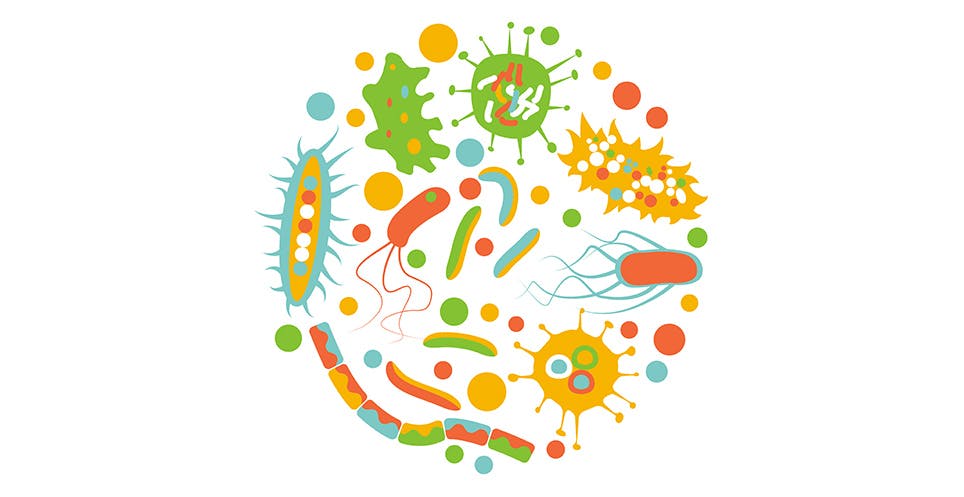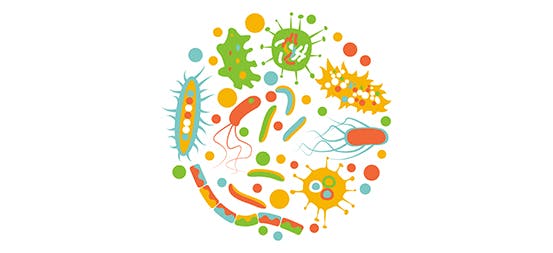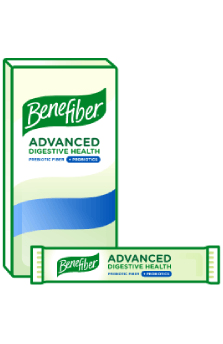The Role of Gut Flora
These bacteria help you live a healthy life.


As many as 1,000 bacterial species live in your GI tract and far outnumber human cells.1 Gut flora are important for everything from metabolism to how your body absorbs nutrients. A diet full of nutritious whole foods can help your good gut flora operate at their maximum potential, promoting your overall health and well-being.
Functions of Gut Flora
Why do you need these bacteria? The two main functions are metabolic and protective.2 Gut flora play a metabolic role by helping your body process fermentable fiber, which travels undigested through the stomach and small intestine, and then ferments in the colon. Your good gut flora synthesize important vitamins—namely, folate, biotin, and vitamin K, which is needed for blood clotting, and the B vitamins, which help your body derive energy from food.
The protective role of good gut flora is to shore up the mucosal barrier—the intestinal lining that keeps “bad" bacteria, or pathogens, from entering the bloodstream and causing disease.
Gut Flora and Health
Your good gut flora are your friends, but may become depleted. For example, you may have had repeated treatments with antibiotics, have a poor diet, or be under stress. When that happens, bad bacteria can wreak havoc in your digestive system and throughout the body. Some of the conditions associated with an imbalance in your gut flora include digestive problems such as diarrhea, constipation, malabsorption, and gastric ulcers.3
Feeding Your Flora
You can increase your good gut flora naturally with the choice of a healthy, whole food diet. In particular, fill your meals with both probiotics and prebiotics. Probiotics are live microorganisms that increase your good gut flora, and you can find them in cultured dairy such as yogurt, kefir, buttermilk and aged cheeses, as well as in fermented non-dairy foods like sauerkraut, kimchi, and tempeh.
Prebiotics , on the other hand, are carbohydrate foods containing specific types of soluble fiber. These fibers are the preferred food of your gut flora, so you literally “feed" your good gut flora with them and support their proliferation. Prebiotic foods include onions, leeks, garlic, bananas, honey, and whole grains.
All Benefiber products however, contain prebiotic fiber. You can also find prebiotics and probiotics in supplement form—in fact, Benefiber Prebiotic Fiber + Probiotics Gummies contains both prebiotics and probiotics in a single product.*
*These statements have not been evaluated by the Food and Drug Administration. These products are not intended to diagnose, treat, cure or prevent any disease.
Use as directed.
Show References
- Guinane, Caitriona M., and Paul D. Cotter. "Role of the Gut Microbiota in Health and Chronic Gastrointestinal Disease: Understanding a Hidden Metabolic Organ." Therapeutic Advances in Gastroenterology. SAGE Publications, July 2013. Web. https://www.ncbi.nlm.nih.gov/pmc/articles/PMC3667473/.
- O'Hara, Ann M., and Fergus Shanahan. "The Gut Flora as a Forgotten Organ." EMBO Reports. U.S. National Library of Medicine, July 2006. Web. http://www.ncbi.nlm.nih.gov/pmc/articles/PMC1500832/.
- "Physiological Effects of Dietary Fibre." FAO Corporate Document Repository. Agriculture and Consumer Protection. Web. http://www.fao.org/docrep/w8079e/w8079e0l.htm.
Nourish the Goodness Inside
Benefiber is an easy way to add fiber to your life.
$1.50 OFF BENEFIBER







